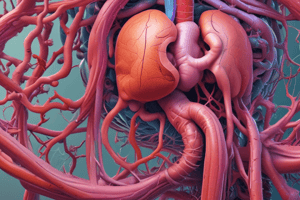Podcast
Questions and Answers
What is the main reason our body needs food and energy?
What is the main reason our body needs food and energy?
- To move, grow, and survive (correct)
- To produce hormones
- To regulate body temperature
- To store fat
What is the primary role of saliva in digestion?
What is the primary role of saliva in digestion?
- To create a feeling of hunger
- To absorb nutrients
- To provide structural support
- To break down carbohydrates into sugar (correct)
What does the process of peristalsis refer to?
What does the process of peristalsis refer to?
- The mixing of food in the stomach
- The breakdown of food by enzymes
- The movement of food through the digestive system (correct)
- The absorption of nutrients in the small intestine
What structure connects the mouth to the stomach?
What structure connects the mouth to the stomach?
What happens during the process of digestion?
What happens during the process of digestion?
What causes the reverse process of peristalsis?
What causes the reverse process of peristalsis?
What mixture is formed in the stomach after digestion?
What mixture is formed in the stomach after digestion?
What are nutrients primarily responsible for in the body?
What are nutrients primarily responsible for in the body?
How long is the small intestine in an average adult human?
How long is the small intestine in an average adult human?
What component of gastric juice helps kill harmful bacteria?
What component of gastric juice helps kill harmful bacteria?
Flashcards are hidden until you start studying
Study Notes
Human Organ System
- The human body consists of several organ systems functioning together as a cohesive unit.
Energy and Food
- Energy and food are essential for bodily movement, growth, and survival.
Digestive System
- The digestive system comprises all body parts involved in digestion.
Digestion Process
- Digestion refers to the transformation of food into simpler forms, necessary as body cells cannot use food in its original state.
Digestion Location
- Digestion takes place in a long tube known as the alimentary canal, extending from the mouth to the anus.
Role of Saliva
- Saliva, produced by salivary glands, is a fluid containing salivary amylase, an enzyme that converts starches into sugars.
Function of Teeth
- Teeth are crucial for mastication, breaking down food into smaller particles through cutting and grinding.
Nutrients
- Nutrients are beneficial components derived from various foods, essential for bodily functions.
Peristalsis
- Peristalsis is the process that moves food through the digestive system, specifically in the esophagus.
Reverse Peristalsis
- If peristalsis occurs in reverse, it can lead to vomiting.
Oesophagus Function
- The oesophagus, approximately 30 cm long, connects the mouth to the stomach and pushes food down using wave-like muscular contractions.
Stomach Function
- The stomach is a muscular, J-shaped organ that mixes food with digestive juices, transforming it into a semi-solid form called chyme. Gastric juice, which includes hydrochloric acid, is secreted to kill harmful bacteria and facilitate digestion.
Small Intestine
- The small intestine is the longest segment of the digestive system, measuring about 20 feet (seven meters). It plays a crucial role in nutrient absorption.
Large Intestine
- Specific functions of the large intestine were not detailed, but it typically involves further absorption of water and preparation of waste for elimination.
Studying That Suits You
Use AI to generate personalized quizzes and flashcards to suit your learning preferences.




